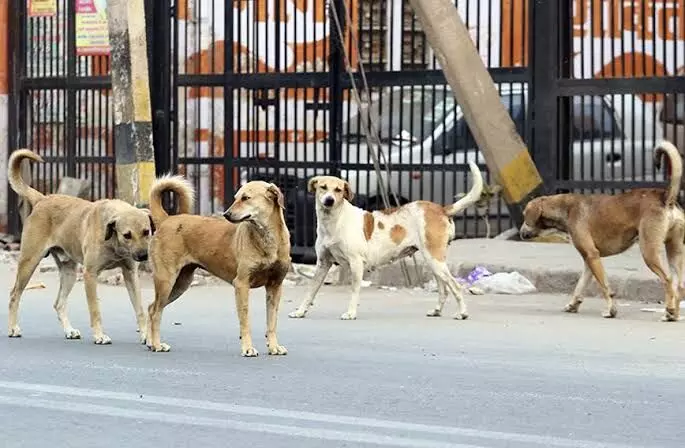India’s stray dog population hits 20 million; resource crunch hits sterilization program
This report provides an overview of government policies
By Anoushka Caroline Williams
India’s stray dog population hits 20 million
Hyderabad: India's stray dog population is estimated to be 1.5 to 2 crore. Managing this population involves a combination of sterilization programs, vaccinations, and temporary shelters, primarily overseen by local municipal bodies.
Animal Birth Control (ABC) Rules, 2023, outline the responsibilities of local authorities and animal welfare organizations (AWOs) in controlling the stray dog population through sterilization and immunization.
Despite legal provisions, funding and infrastructure gaps remain a challenge. The Animal Welfare Board of India (AWBI) provides financial assistance to recognized AWOs for sheltering, rescuing, and treating stray dogs. However, data shows that the central funding for stray dog birth control and immunization has significantly declined in recent years.
Animal rights activists argue that while policies exist, their implementation remains inconsistent. “Local authorities often lack the resources to carry out large-scale sterilization programs, and shelters are overcrowded,” said Anahita Joshi, an animal welfare activist speaking to NewsMeter. “The focus should be on sustained funding and community involvement.”
This report provides an overview of government policies, financial allocations, and implementation gaps in India’s dog shelter and welfare ecosystem.
Legal Framework for Stray Dog Management
Constitutional Provisions
• Animal husbandry is a state subject under Article 246(3) of the Constitution.
• Article 243(W) empowers local bodies to manage stray animals as per the Twelfth Schedule.
Animal Birth Control (ABC) Rules, 2023
• Sterilization & Vaccination: Local bodies must implement sterilization and rabies vaccination programs for stray dogs.
• Temporary Sheltering: Stray dogs can only be housed in shelters if they are sick or aggressive; after recovery, they must be released back to their original location.
• Role of Animal Welfare Organizations: AWOs must care for sick or aggressive dogs before reintegrating them into the community.
Animal activists believe these rules, while clear, are difficult to enforce. Dr. Rashi Verma, a veterinarian working with an animal rescue center in Delhi, pointed out, “Many municipal bodies struggle to build enough kennels or provide medical care, which leads to delays in sterilization and vaccination programs.”
Funding for Stray Dog Welfare
The Animal Welfare Board of India (AWBI) provides financial assistance to animal welfare organizations (AWOs) under various schemes. In the past five years, funding for Regular & Rescue Grants has increased significantly, from ₹1.55 crore in 2019-20 to ₹4.08 crore in 2023-24.
However, funding for Shelter Grants has seen a decline, dropping from ₹2.50 crore in 2019-20 to ₹42.22 lakh in 2023-24. Ambulance Grants, which provide emergency transport for injured or sick animals, received ₹26.39 lakh in 2019-20, peaking at ₹49.41 lakh in 2020-21, before being discontinued in 2023-24. The Natural Calamity Grant, intended for animal rescue during disasters, saw only minimal allocations, with ₹2 lakh in 2020-21 and ₹50,000 in 2022-23.
In contrast, central funding for Birth Control and Immunization of Stray Dogs has sharply declined. The scheme received ₹24.4 lakh in 2018-19, reducing to ₹7.3 lakh in 2019-20 and ₹4.03 lakh in 2020-21. Since 2021, no central funds have been allocated, shifting the financial responsibility entirely to state governments and local municipal bodies.
Policy Implementation and Awareness Efforts
• The ABC Rules, 2023, were communicated to all state and municipal authorities in March 2023 for compliance.
• The Department of Animal Husbandry & Dairying issued an advisory in November 2024, reinforcing the need for effective stray dog population control.
• On World Rabies Day (September 28) each year, AWBI promotes mass vaccination drives for stray dogs.
Despite these efforts, implementation gaps persist. Tabitha Shankar, an activist from Hyderabad, stated, “Sterilization programs often face delays due to a lack of trained personnel and funding shortages. Without continuous support, the stray dog population will keep increasing.”
Challenges in Stray Dog Management
Animal welfare organizations and activists highlight several key challenges in implementing dog shelter and population control measures:
1. Inconsistent Implementation: Many local bodies lack the necessary infrastructure and resources to conduct effective sterilization and vaccination drives.
2. Funding Shortfalls: The decline in central funding for birth control programs has left many shelters struggling with limited resources.
3. Public Resistance to Relocation: Community opposition to stray dog relocation efforts disrupts ABC initiatives, as people fear that removing dogs will lead to new strays occupying the area.
4. Limited Adoption Initiatives: While AWBI promotes the adoption of indigenous dog breeds, awareness remains low, and very few adoption programs are actively promoted at the local level.
Conclusion
Managing India’s stray dog population requires sustained funding, proper enforcement of policies, and public participation. While government programs exist, funding inconsistencies, infrastructural gaps, and enforcement challenges continue to hinder progress. Strengthening the ABC program, increasing adoption awareness, and improving shelter facilities are critical steps in ensuring humane and effective stray dog management in the country.
Animal activists stress that the issue is not just about funding, but also about changing public attitudes. “Stray dogs are not a nuisance; they are part of our communities,” said Joshi. “With better management, vaccination, and responsible adoption, we can create a system where both humans and animals coexist safely.”